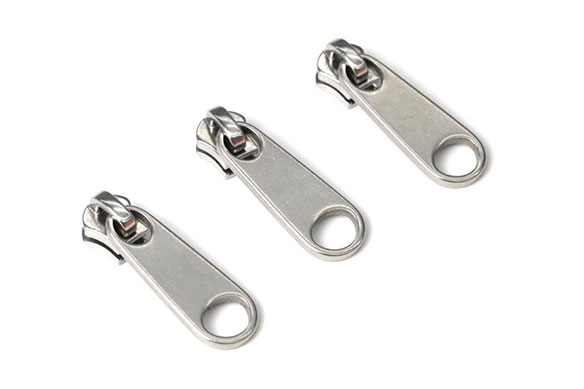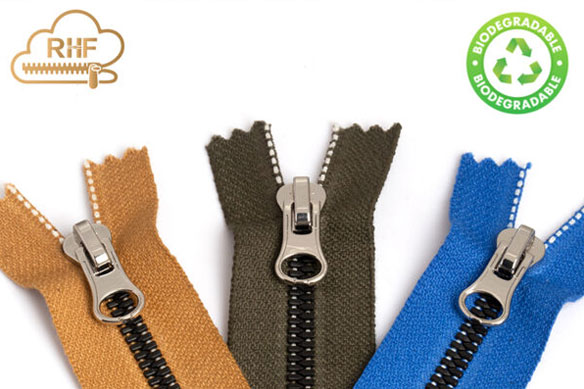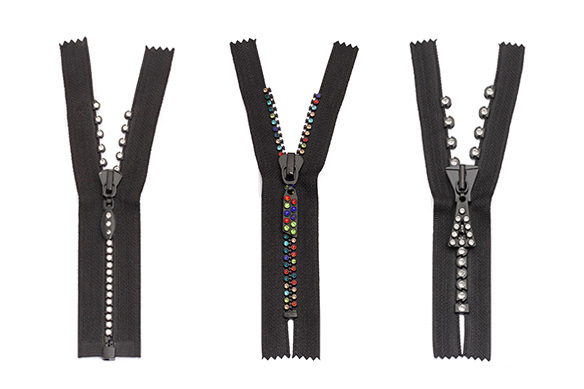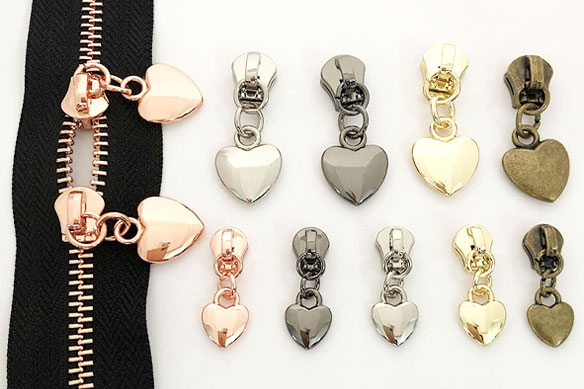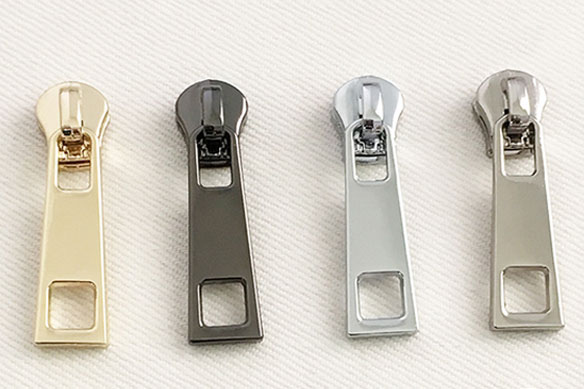Introduction
Zipper pullers might seem like small details, but they’re critical components that impact the look, feel, and performance of finished products. For manufacturers and designers in industries like apparel, bags, outdoor gear, and even furniture, choosing the right puller material is an important decision.
Among the options available, stainless steel zipper pullers stand out for their durability and distinctive finish. But they’re not always the default choice—understanding why, and when they make sense, is essential for making informed sourcing decisions.
1. What Are Stainless Steel Zipper Pullers?
Stainless steel zipper pullers are made from corrosion-resistant steel alloys designed to maintain strength and appearance over time. Unlike the more common zinc alloy pullers, stainless steel pullers are often produced using machining, laser cutting, or precision casting methods that can handle tougher materials but take longer to process.
These pullers are typically used in contexts where durability and corrosion resistance are crucial, such as outdoor equipment exposed to the elements, marine gear, or high-end military or technical clothing.
While zinc alloy remains the most popular choice for its design flexibility and lower cost, stainless steel is chosen when performance requirements justify the trade-offs.
2. Key Features of Stainless Steel Pullers
Stainless steel offers several specific properties that make it attractive in certain applications:
- Corrosion Resistance: Performs well in humid, wet, or even marine environments without rusting.
- Strength and Durability: Withstands heavy use and repeated stress without deforming or breaking.
- Premium Appearance: Supports polished or brushed finishes for a high-end look.
- Environmental and Compliance Benefits: Can help meet stricter environmental or safety standards required by some brands.
- Heat and Chemical Resistance: Suitable for specialty uses like firefighting gear or uniforms exposed to harsh conditions.
Choosing stainless steel is often about solving a real-world problem—like avoiding corrosion failures in wet environments, or ensuring long-term strength for products with demanding usage cycles.
Table 1: Stainless Steel vs. Zinc Alloy Zipper Pullers – Features at a Glance
| Feature | Stainless Steel | Zinc Alloy |
|---|---|---|
| Corrosion Resistance | Excellent (suitable for marine/outdoor) | Moderate (may corrode over time) |
| Strength & Durability | High, resists deformation | Good, but softer and more prone to wear |
| Cost | Higher | Lower |
| Production Time | Longer (machining-intensive) | Faster (casting-friendly) |
| Design Flexibility | Limited (harder to mold intricate shapes) | Excellent (complex designs easier) |
| Appearance Options | Polished, brushed finishes | Wide range of plating/colors available |
3. Benefits of Stainless Steel Zipper Pullers
While they’re not the most economical option, stainless steel pullers deliver real advantages for specific needs:
- Long-Term Reliability: They maintain their shape and function even after years of use, reducing failure rates and customer complaints.
- Premium Brand Positioning: The weight and finish of stainless steel convey quality, making them a good fit for luxury bags, outdoor technical gear, or specialty uniforms.
- Best for Challenging Environments: Ideal for products that need to perform in rain, saltwater, or high-humidity settings without rust or degradation.
- Supports Compliance Goals: For brands needing to meet environmental or chemical safety standards, stainless steel may simplify certification processes.
For outdoor gear manufacturers, for example, using stainless steel pullers can help ensure their products meet the expectations of customers who rely on them in tough conditions. Likewise, high-end fashion brands may choose stainless steel to signal quality and durability in their accessories.
4. Limitations and Considerations
While stainless steel zipper pullers have clear advantages, it’s equally important to understand their limitations. Choosing them blindly for every application can lead to cost overruns, production delays, or over-engineered solutions.
Key considerations include:
- Higher Cost: Stainless steel is more expensive as a raw material and requires more time-consuming machining or finishing processes. This affects unit cost, especially for large production runs.
- Production Time: Unlike zinc alloy, which is well-suited to mass production through casting, stainless steel often involves slower processes such as CNC machining or laser cutting. Lead times may increase.
- Design Flexibility: Zinc alloy offers superior moldability, making it easier to achieve intricate shapes, logos, or custom designs. Stainless steel is harder to mold, limiting some creative options.
- Suitability for Volume: For brands producing high-volume, cost-sensitive products, stainless steel may be overkill when zinc alloy provides adequate performance at lower cost.
From experience in the zipper industry, many B2B buyers choose stainless steel only when its advantages solve a specific, critical need—rather than treating it as a general-purpose solution.
5. When Should You Choose Stainless Steel?
Deciding whether to use stainless steel pullers depends on balancing performance needs with cost and production realities. Below are practical guidelines for manufacturers and designers.
✅ Recommended Scenarios:
- Outdoor or marine equipment exposed to rain, salt, or humidity.
- Military or safety gear needing high strength and reliability.
- High-end bags or apparel lines where the puller’s finish conveys premium quality.
- Products requiring compliance with stricter environmental or safety standards.
✅ Scenarios Where Zinc Alloy May Be Better:
- Fashion items needing frequent style changes or intricate branding.
- Large production runs with tight cost constraints.
- Designs requiring complex shapes or fine detail.
- Products with limited exposure to moisture or demanding environments.
Table 2: When to Choose Stainless Steel vs. Zinc Alloy (Decision Guide)
| Scenario | Recommended Material | Reason |
|---|---|---|
| Outdoor or marine gear | Stainless Steel | Corrosion resistance, strength |
| Luxury fashion accessories | Stainless Steel / Zinc Alloy | Premium finish vs. design flexibility |
| Large-scale cost-sensitive runs | Zinc Alloy | Lower cost, faster production |
| Highly customized intricate designs | Zinc Alloy | Easier to mold complex shapes |
| Safety/military uniforms | Stainless Steel | Durability, heat/chemical resistance |
✅ Tips for Manufacturers and Sourcing Teams:
- Clearly communicate intended use environments to suppliers.
- Discuss production timelines and MOQ requirements upfront.
- Consider prototyping to validate appearance and performance before committing to large runs.
- Evaluate certification needs early to ensure the material supports regulatory requirements.
Conclusion
Stainless steel zipper pullers offer clear advantages where durability, corrosion resistance, and premium appearance are required. But they also come with higher costs and production challenges that don’t suit every project.
For manufacturers, designers, and sourcing teams, the best approach is to evaluate real-world product requirements carefully. By understanding the strengths and limitations of stainless steel—and comparing them honestly with zinc alloy and other materials—you can make choices that balance quality, cost, and production efficiency.
An informed decision leads not just to a better zipper puller, but to a better product overall, helping brands deliver on their promises to customers. If you’d like to discuss your specific requirements or get expert input, you can contact us here.

